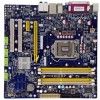Foxconn Q57M English Manual. - Page 35
► DRAM Timing Controlled, ► CAS Latency Time tCL, ► RAS# Precharge tRP, ► Precharge Delay tRAS, ►
 |
View all Foxconn Q57M manuals
Add to My Manuals
Save this manual to your list of manuals |
Page 35 highlights
Advanced Chipset Features CMOS Setup Utility - Copyright (C) 1985-2009, American Megatrends, Inc. Advanced Chipset Features System Memory Frequency DRAM Timing Controlled DRAM Frequency Memory Hole ► Trusted Computing Initiate Graphic Adapter Pre Allocated Memory ► Video Configuration :800MHz Help Item [By SPD] [Auto] Options [Disabled] By SPD [Press Enter] Manual [PCI/PCIE] [Enabled, 32MB] [Press Enter] 3 Move Enter:Select +/-/:Value F10:Save ESC:Exit F1:General Help F7:Previous Values F8:Fail-Safe Defaults F9:Optimized Defaults ► DRAM Timing Controlled This item is used to enable/disable provision of DRAM timing by SPD device. The Serial Presence Detect (SPD) device is a small EEPROM chip, mounted on a memory module. It contains important information about the module's speed, size, addressing mode and various other parameters, so that the motherboard memory controller (chipset) can better access the memory device. Select [Auto] for SPD enable mode. Select [Manual] to set the parameters by yourself. The following 4 settings are valid only when the Memory Timing by SPD is set to [Manual]. ► CAS Latency Time (tCL) This item controls the CAS latency, which determines the timing delay (in clock cycles) before SDRAM starts a read command after receiving it. ► RAS# to CAS# Delay (tRCD) This item allows you to select a delay time (in clock cycles) between the CAS and RAS strobe signals. ► RAS# Precharge (tRP) This item allows you to select the DRAM RAS precharge time (in clock cycles). ► Precharge Delay (tRAS) This item allows you to set the precharge delay time (in clock cycles). ► DRAM Frequency This item is used to adjust the memory speed. Select [Auto] for SPD enable mode. You can select a value manually such as [800 MHz], [1067 MHz] and [1333MHz].. ► Memory Hole This item is used to set the memory hole. The available values are [Disabled] and [Enabled]. Some special ISA cards require this area of memory for them to work properly. Enabling this function reserves the memory area for the card's use. In some cases, it may also prevent the system from accessing memory above 15MB. If you enable this function, 1MB of RAM (the 28















